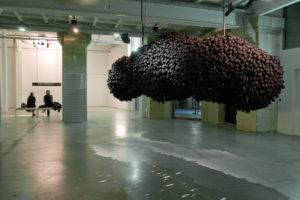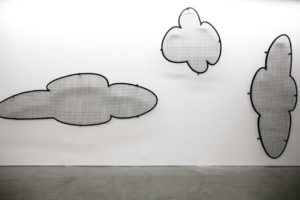Shilpa Gupta’s artistic quest has been directed towards the manifestation of the audible but immaterial surplus of experience, a surplus of affect and reason that eludes easy consumption. This is especially true of her series on the singing microphones.
The microphone is a much (ab)used trope in public memory as well as world cinema: it is often the medium through which history is, quite literally, made – as utterance, declaration, proclamation, or fiat. Broadcast speech has woken a nation to freedom while the world slept (Nehru’s Independence Eve speech, 15 August 1947, beginning “At the stroke of the midnight hour”). It has also assaulted an entire civilization, when Chaplin as Hitler abused the microphones with his phoney German till they shrank in shame and hurt (The Great Dictator, 1940).

It is with Singing Cloud (2008-2009), a gigantic beast breathing through the mouths of 4000 microphones that Gupta calls us to witness the power of the disembodied voice as the presence of all that is occluded. Is this the last and final call for democracy: thousands of voices waiting their turn to shape their grievances into spit-balls of protest? No, this monster of microphones doesn’t stir, doesn’t recoil at the viewer’s speech. From the 48 speakers embedded in this installation suspended from the ceiling, come various sounds. We hear a child-like voice singing a rhyme, “I want to fly high above in the sky/Don’t push me away”, which, although seemingly light in content, is scored through a polyphony of sonic associations: an ocean of sleep, waves of the unsaid, ruptured snoring, the errata of faith, the recitation ‘Rales Allahus’ merging Ram, Jesus and Allah, the gurgling of piped water, the immensity of the sky, the intensity of a wingbeat. The microphones do not carry our sounds, but bring sounds to us. Who speaks? Who listens?
This cloud weighs on us, as that prophet of class struggle had predicted long ago, ‘like a nightmare on the brains of the living’. Why does it take on the urgency of the mute poet boarding the train to Siberia; the soul-shattering sound of Kristallnacht; the broken voice of the Kashmiri half-widow breaking with grief; the unbearable silence of the children of Iraq who died in their sleep during the US bombing raids; and the unborn voices of children ripped from the womb during the Gujarat pogrom? In Gupta’s Singing Cloud, we are stained by the inaudible but very palpable voices of people abandoned by history.

And the voice reciting its rhyme of utopian escape? We have heard this voice before: as lament, as hysteria, as petulance, as plain silliness. It is the voice of the artist: her favoured stratagem is to play the child who can costume herself in innocence and indulgence, to unmask social and political asymmetries without suffering the punitive consequences of truth-telling. The child cares little for adult tact. In Gupta’s counter-patriarchal handling, the girl child is allowed to play havoc with societal norms and break all taboos. Far from being infantile antics, as the Austrian-born child psychologist and writer Bruno Bettelheim showed, fairy tales and nursery rhymes could be read as presentiments and auguries of catastrophes like famine or plague.
Who then will speak the truth to power? Who will stuff your face with sugar kidneys till you hurt, teach you a new alphabet that will scald your tongue? Who will dive in and out of your body till you learn that darkness is everything that light will never be? She will, because while she sleeps, she does not let reason sleep or faith escape. She keeps a vigil at ghost stations, at flapboards that open out vast distances between people, names of places, histories of catastrophes and dates (Untitled, 2008-2009).¹ Until they all get scrambled thoroughly, mismatched, mixed and matched to evade fact and meaning. Sometimes, a decipherable text falls into place, announcing Age Sex Religion Fly.
Endnotes
- Singing Cloud (2008-2009) and the flapboards Untitled (2008- 2009), were made for the exhibition ‘While I Sleep’, organised by Le Laboratoire, Paris, in February 2009. Le Laboratoire facilitated a collaborative project between Shilpa Gupta and Mahzarin Banaji, professor of psychology at Harvard, to understand how the psychology of ‘fear’ and ‘prejudice’ operates in people belonging to different races, genders and religions. According to Banaji, between 80 percent and 90 percent of our mental life is subconscious. This insight led Gupta to study the results of the Implicit Association Tests (IAT) developed by Banaji and other psychologists and legal scholars, to understand whether prejudice on the basis of race or religion is genetic, or a reflex ingrained by social conditioning, or some atavistic psychic relic in the subconscious, which dictates our conscious actions. Gupta has incorporated the research findings from this project into Singing Cloud and Untitled (2008-2009).














